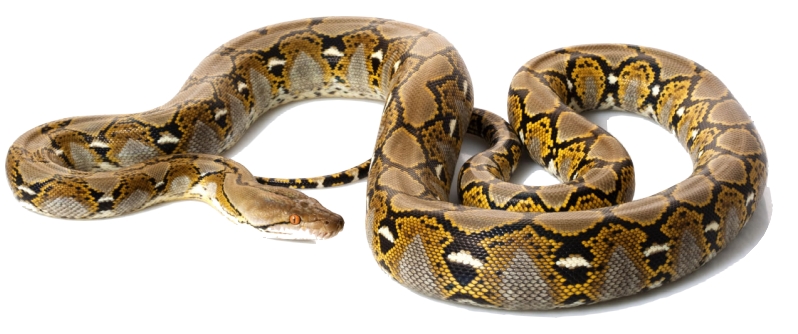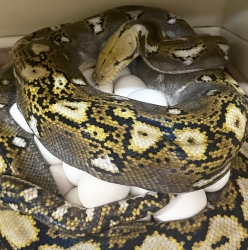   Despite the incredible lengths of some individuals, most are less than 5 meters long and weigh between 75 and 175 kg. (The heaviest snake is the green anaconda). Reticulated pythons have grayish tan bodies with X- or diamond-shaped blotches containing black, white, yellow, and red scales. The eyes are orange with vertical pupils that open in dim light. Embedded in the lip scales are heat-sensing pits that can detect any object or prey whose temperature exceeds that of the surrounding environment. Despite the incredible lengths of some individuals, most are less than 5 meters long and weigh between 75 and 175 kg. (The heaviest snake is the green anaconda). Reticulated pythons have grayish tan bodies with X- or diamond-shaped blotches containing black, white, yellow, and red scales. The eyes are orange with vertical pupils that open in dim light. Embedded in the lip scales are heat-sensing pits that can detect any object or prey whose temperature exceeds that of the surrounding environment.
The snake is active at night, concealing itself in trees and tall grasses, and even sewers in urban areas, until a bird, mammal, or reptile comes within striking range. A strike is triggered by the vibrations or heat of the snake's prey. Using both caterpillar and serpentine (side-to-side) movements, the snake climbs trees, swims across rivers, and ventures into meadows, farmland, and even cities. Its prey includes bats and tree shrews and animals as large as pigs, deer, and monitor lizards. In developed areas, household pets are sometimes taken. In rare instances, the snake has attacked and killed people. Human victims have included individuals who lived in wilderness areas, as well as people who kept the snake as a pet. The python typically grabs the prey's head with its teeth and coils tightly around the prey to suffocate it, which can occur in three to four minutes. After a large meal, the snake is inactive for weeks while the food is digested. 
 Like all snakes, reticulated pythons are deaf to airborne noises, and visually restricted due to immovable eyelids. This requires the python to rely on its sense of smell and touch to locate predators and prey. The reticulated python does not have ears; instead it has an organ which allows the python to sense the vibrations in the ground. Due to the absence of ears, snakes and other pythons must use physical movements to create vibrations in order to communicate to one another. Vibrations are used to initiate mating or warn other pythons of a possible territorial dominance. Although the reticulated python possesses nasal cavities, the sense of smell is conducted by the use of the forked tongue to flick air particles towards the vomeronasal organ which is located on the roof a snake's mouth. The reticulated python also communicates with other snakes by using a series of pheromones applied to the topsoil of forest floor. These pheromones allow other snakes to interpret the gender, reproductive success, and age by smelling them. Especially in presence of females, pythons have been known to initiate combat with a fellow male python in order to establish dominance and attract a mate.  Every 2-4 years, depending on the availability of prey, a female deposits a clutch of 20–100 eggs. Like most pythons, it is oviparous, meaning it lays eggs to reproduce. After laying eggs, the female python incubates them in a nest for about 90 days until they are ready to hatch. Unlike most species, the reticulated python female remains coiled above the incubating eggs in order to provide warmth. Through a process of muscle contractions, a female reticulated python can warm up the eggs beneath them, causing an increase in the rate of incubation and chances of survival. With nearly no parental care after birth, it is the newly hatched python baby's job to find food and protection. The hatchlings are roughly 60 cm in length and weigh around 140 grams.
Every 2-4 years, depending on the availability of prey, a female deposits a clutch of 20–100 eggs. Like most pythons, it is oviparous, meaning it lays eggs to reproduce. After laying eggs, the female python incubates them in a nest for about 90 days until they are ready to hatch. Unlike most species, the reticulated python female remains coiled above the incubating eggs in order to provide warmth. Through a process of muscle contractions, a female reticulated python can warm up the eggs beneath them, causing an increase in the rate of incubation and chances of survival. With nearly no parental care after birth, it is the newly hatched python baby's job to find food and protection. The hatchlings are roughly 60 cm in length and weigh around 140 grams. The species becomes sexually mature between ages 3 and 5. The longest known lifespan of a reticulated python in captivity is 32 years. In contrast, the longest recorded lifespan of a wild reticulated python is 23 years. Reticulated pythons, like all snakes, must shed their skin in order to repair injuries or during developmental stages of life. The shedding of a snake's skin is necessary in order to facilitate their ever-growing bodies. Predators of reticulated pythons are nearly nonexistent because of the snake's large size. Python eggs and newly-hatched pythons are at risk from predators such as birds (hawks, eagles, herons) and small mammals. However, the predation on adult pythons is very rare and limited to crocodiles and other large predators. Pythons are only at a high risk of predation near the edges of bodies of water where crocodiles might be waiting to attack. The only defense against predators, besides size, is a powerful constriction by the snake's body which can literally squeeze the life out of an organism an around 3 to 4 minutes.  The reticulated python, like other snakes worldwide, plays a key role in controlling rodent populations in environments near farmlands and grasslands. The reticulated python, like other snakes worldwide, plays a key role in controlling rodent populations in environments near farmlands and grasslands. Nevertheless, because of its large size, the snake is hunted and sold internationally for its skin as well as its meat. Large demands to own exotic animals have also resulted in reticulated pythons being captured for the pet trading market, to be sold all over the planet. |